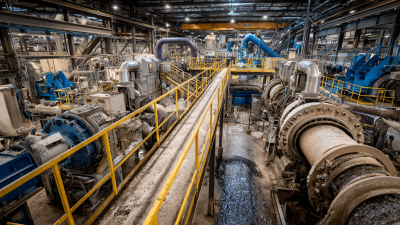

In today’s fast-changing world of Oil Petroleum Engineering, making sure projects succeed and stay compliant is more important than ever. The International Energy Agency (IEA) predicts that by 2026, global oil demand could hit around 104 million barrels a day—that’s a ton of stuff needing to be produced efficiently and with smart solutions. As everyone works to keep up with these growing demands, companies like Shanghai Shangjiang Petroleum Engineering Equipment Co., Ltd. are playing a really key role. We’re dedicated to developing advanced separation and filtration equipment that’s absolutely essential for the oil and gas industry. Our experience with cyclone separation technology puts us right at the forefront of tackling the industry’s challenges. As we take a closer look at the Ultimate Oil Petroleum Engineering Checklist, it’s super important to include compliance measures that meet industry standards and promote sustainability. That way, we’re setting up a stronger, more resilient future in petroleum engineering.

Having a solid oil and petroleum engineering checklist is pretty much essential if you want your project to go smoothly and stay in line with industry rules. I mean, according to the International Energy Agency, the world’s oil demand is expected to hit around 104.1 million barrels per day by 2026, so it’s clear that a thorough and careful engineering approach is more important than ever. A good checklist should cover key points like sticking to environmental laws, safety standards, and keeping operations efficient. When you focus on these things, engineers can actually cut down on the risks that come with drilling and production — it’s all about staying safe and on track.
And here’s the thing—adding some tech into the mix really helps. This isn’t just about keeping paperwork straight; digital tools can make managing data and making decisions way easier. A report from the Society of Petroleum Engineers mentions that using digital tech in project management can cut costs by up to 20%. Pretty impressive, right? Plus, with these tools, teams can spot problems early on and keep everything on schedule and within budget. So, a well-made checklist isn’t just about ticking boxes — it’s about pushing the industry towards smarter, more efficient practices while making sure we follow all the rules.
| Checklist Element | Description | Compliance Status | Comments |
|---|---|---|---|
| Project Scope Definition | Clearly defined project objectives and deliverables. | Compliant | Reviewed and approved by stakeholders. |
| Regulatory Compliance | Adhering to local, national, and international regulations. | Compliant | All permits obtained. |
| Risk Assessment | Identifying potential risks and mitigation strategies. | Needs Attention | Additional analysis required. |
| Budget Planning | Detailed project budget and financial planning. | Compliant | Under budget forecast. |
| Environmental Impact Assessment | Evaluating project's environmental consequences. | Compliant | Mitigation plans in place. |
| Quality Assurance Plan | Standards and procedures to ensure project quality. | Compliant | Plan approved. |
In the fast-changing world of oil engineering, spotting and dealing with project risks is pretty much the key to making sure everything turns out well and stays compliant. I came across a recent study that looked at how different industries handle risk management, and it showed that having a solid plan in place can really cut down on potential problems. By taking a proactive stance, oil and gas companies can mix traditional methods with newer, innovative strategies—kind of like blending the best of both worlds—to better handle the uncertainties they face. This approach also encourages teamwork, breaks down barriers, and creates a more resilient, efficient way of running operations.
On top of that, using Industry 4.0 tech—stuff like AI and the Internet of Things—can really help mitigate risks. These tools help companies run smarter, make better decisions, and smooth out their processes. Techniques like stress testing, which involve running simulations to check financial health, are super useful for predicting what might go wrong before it actually happens. Bottom line? A solid risk management plan that leverages new tech and promotes teamwork can give the oil industry a real boost, helping them perform better while staying on the right side of regulations.
This chart illustrates various strategies used in oil engineering projects to identify and mitigate risks, along with their effectiveness ratings based on industry surveys.
In the oil and gas world, sticking to the right standards is a big deal if you want your project to succeed. Not only do these rules keep everything safe and running smoothly, but they also help protect the environment and show that companies care about social responsibility. It’s really important for companies to follow local, national, and even international regulations—stuff like emissions limits, waste handling, and worker safety protocols. When everyone plays by the rules, it’s easier to cut down on risks, steer clear of expensive legal troubles, and build good relationships with communities and stakeholders alike.
On top of that, keeping a close eye on compliance throughout the entire project is super crucial. That means doing regular audits, risk assessments, and training sessions to make sure everyone knows what they’re supposed to do. Staying connected with regulatory agencies and industry groups can also help companies stay updated on any new rules or changes. Ultimately, by making compliance a top priority, companies don’t just protect their projects—they also boost their reputation as responsible players in the oil and gas scene. It’s all about doing things right and showing you care.
 In today’s fast-moving tech world, good communication and teamwork are more important than ever. Did you know that the market for Unified Communication and Collaboration (or UC&C for short) is expected to hit around $150 billion by 2032? It’s growing at a pretty quick pace—about 10.8% annually! This really highlights how vital it is for businesses to smoothly bring together different communication tools so teams can work better together. For industries like petroleum engineering, where accuracy and collaboration are key, keeping up with this rapid growth isn’t just smart—it’s necessary to stay on top, hit project goals, and stay compliant.
In today’s fast-moving tech world, good communication and teamwork are more important than ever. Did you know that the market for Unified Communication and Collaboration (or UC&C for short) is expected to hit around $150 billion by 2032? It’s growing at a pretty quick pace—about 10.8% annually! This really highlights how vital it is for businesses to smoothly bring together different communication tools so teams can work better together. For industries like petroleum engineering, where accuracy and collaboration are key, keeping up with this rapid growth isn’t just smart—it’s necessary to stay on top, hit project goals, and stay compliant.
With all this in mind, organizations should really focus on adopting some good practices to boost teamwork. Things like being transparent, giving regular feedback, and involving everyone in decision-making can help build a real collaborative culture. Using digital communication tools smartly can also make workflows smoother, allowing teams to handle challenges faster and stay innovative. As the industry landscape keeps changing—sometimes really fast—those who put a priority on effective communication will have a better shot at thriving in the competitive scene ahead.
Managing petroleum projects really takes more than just technical know-how. It’s about constantly looking for ways to get better—that’s where continuous improvement techniques come into play, boosting efficiency and making sure everything stays compliant. For example, according to the International Association of Oil & Gas Producers (IOGP), using data-driven strategies can actually improve decision-making by up to 30%. That really highlights how powerful technology can be when it comes to project management. When project managers tap into advanced analytics and monitor real-time data, they can spot inefficiencies early on and tweak their approach before small issues turn into big problems.

Oh, and a little tip—make sure to keep your team up-to-date with the latest tools and methods. Investing time in ongoing training not only ramps up productivity but also helps build a culture that's eager to innovate, which is super important given how fast the petroleum industry changes.
And let’s not forget about agility. Switching to a more flexible, agile approach can really boost your responsiveness to market shifts. A recent Deloitte report pointed out that companies using agile practices managed to cut down their project delivery times by about 20%. That kind of adaptability is key for staying competitive, especially with regulations that are always evolving.
One more thing—regularly reviewing your compliance procedures to stay in line with new policies is a smart move. Being proactive like this not only helps you avoid regulatory hiccups but also shows your commitment to safety and protecting the environment. Basically, staying ahead of these things keeps your projects running smoothly and your reputation intact.
: Effective risk management is crucial in oil engineering to ensure project success and compliance, reducing project risks through proactive planning.
By adopting a proactive approach that fosters collaboration and eliminates silos, oil and gas companies can enhance their ability to navigate uncertainties effectively.
Technologies like artificial intelligence and the Industrial Internet of Things (IoT) help streamline processes and improve decision-making, essential for mitigating risks.
Compliance standards include protocols related to emissions, waste management, and occupational health and safety, ensuring safety, integrity, and environmental protection.
Engaging with regulatory bodies and industry groups, along with conducting regular audits and training, helps companies stay abreast of changes in compliance requirements.
Implementing data-driven strategies and utilizing advanced analytics can improve decision-making by up to 30% and help identify inefficiencies early.
Regular training enhances productivity and cultivates an innovative culture that responds effectively to the dynamic challenges in the petroleum industry.
Agile methodologies increase responsiveness to market changes and have been shown to reduce project delivery time by 20%, enhancing competitiveness.
Conducting periodic reviews of compliance protocols ensures alignment with the latest policies and reinforces commitments to safety and environmental stewardship.
Stress testing techniques allow companies to assess financial stability through simulations, enabling them to anticipate and prepare for potential challenges in projects.
In the world of Oil Petroleum Engineering, how successful a project is really depends on having a solid checklist in place. This includes key stuff like spotting potential risks early on and figuring out how to handle them, making sure everything lines up with industry standards, and keeping the lines of communication open among team members. When teams set up good practices and work together smoothly, they can run things more efficiently and stay on top of regulations, which helps avoid a lot of avoidable setbacks.
On top of that, always looking for ways to improve is super important if you want to stay ahead in project management within the oil and gas industry. Companies like Shanghai Shangjiang Petroleum Engineering Equipment Co., Ltd. are really stepping up by creating cool, innovative separation and filtration gear that supports these kinds of efforts. By bringing in the latest tech — like better cyclone separators — teams can get the best results while still keeping safety and compliance a top priority. It’s all about pushing forward without losing sight of the fundamentals.






